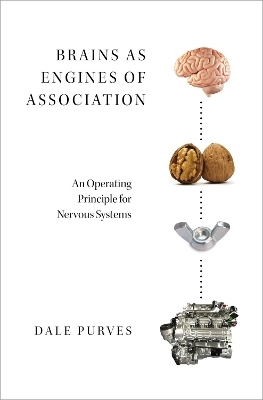
Brains as Engines of Association
Oxford University Press Inc (Verlag)
978-0-19-088016-3 (ISBN)
Brains as Engines of Association tackles a fundamental question in neuroscience: what is the operating principle of the human brain?
While a similar question has been asked and answered for virtually every other human organ during the last few centuries, how the brain operates has remained a central challenge in biology. Based on evidence derived from vision, audition, speech and music--much of it based on the author's own work over the last twenty years--Brains as Engines of Association argues that brains operate wholly on the basis of trial and error experience, encoded in neural circuitry over evolutionary and individual time.
This concept of neural function runs counter to current concepts that view the brain as a computing machine, and research programs based on the idea that the only way to answer such questions is by reconstructing the connectivity of brains in their entirety. This view also implies that the best way to understand the details of brain function is to recapitulate their history using artificial neural networks. While this viewpoint has received support in the last few years from work showing that computers can win complex games, the brain plays a much more complex game--the "game" of biological survival--which Purves concludes is based on trial-and-error experience.
Dale Purves is Geller Professor of Neurobiology Emeritus at Duke University, where he moved in 1990 as the founding chair of the Department of Neurobiology. He was subsequently Director of Duke's Center for Cognitive Neuroscience and the Director of the Neuroscience and Behavioral Disorders Program at the Duke-NUS Graduate Medical School in Singapore. His research has sought to explain why we see and hear what we do. He is a member of the National Academy of Sciences, the American Academy of Arts and Sciences, and the National Academy of Medicine.
Preface
PART I. What Nervous Systems Do for Animals
Chapter 1. Putting the Question in Perspective
Introduction
Life on Earth
Defining life
Energy
Evolution
Mechanisms
Teleology
Conclusion
Suggested Reading
Chapter 2. Organisms without Nervous Systems
Introduction
Bacteria
Protists
Plants
The general strategy
Conclusion
Suggested Reading
Chapter 3. Organisms with Nervous Systems
Introduction
Defining nervous systems
The emergence of nervous systems
The emergence of central nervous systems
What do nervous systems add?
What do brains add?
Conclusion
Suggested Reading
PART II. Neural Systems as Engines of Association
Chapter 4. The Organization of Nervous Systems
Introduction
Stimuli
Pre-neural processing
Neural processing
Behavioral output
Neural systems and subsystems are interactive
Conclusion
Suggested Reading
Chapter 5. The Problem
Introduction
Vision as an example
The basic challenge
The answer in general terms
Qualia determined by empirical ranking
Perceptual discrepancies
Mechanisms
Other modalities
The meaning of 'illusions'
Conclusion
Suggested Reading
Chapter 6. Neural Associations
Introduction
Associations wrought be evolution
Associations wrought by lifetime learning
Associations wrought by culture
Behavioral categories of associations
Reward
Behavioral responses as reflexes
What gets associated?
Counterarguments
Conclusion
Suggested Reading
PART III. Evidence that Neural Systems Operate EMPIRICALLY
Chapter 7. Evidence from Lightness and Color
Introduction
Luminance and lightness
Analyzing the occurrence of luminance patterns
Effects of other luminance patterns
Spectral energy and color
The general strategy
Conclusion
Suggested Reading
Chapter 8. Evidence from Geometry
Introduction
Seeing intervals
Seeing angles
Seeing object sizes in 2-D
Seeing object sizes in 3-D
Seeing stereo depth
Conclusion
Suggested Reading
Chapter 9. Evidence from Motion
Introduction
Apparent motion
The perception of speed
Implications for the perception of time
The perception of direction
Conclusion
Suggested Reading
Chapter 10. Evidence from Audition
Introduction
Sound signals
Sources of tones
Sound signal spectra
The problem in audition
An empirical approach
Evidence from speech
Evidence from music
Implications for any sensory system
Conclusion
Suggested Reading
PART IV. alternative Concepts Neural Function
Chapter 11. The Major Options
Introduction
Neural function as feature detection
Neural function as statistical inference
Neural function as efficient coding
Neural function as computation
Conclusion
Suggested Reading
Chapter 12. Summing Up
Introduction
A way around some fundamental obstacles
Empirical ranking
Insight from games
Artificial intelligence
Consequences for neuroscience
The status of reasoning
Novel situations
Choice
Culture
The frequency of stimuli
Conclusion
Suggested Reading
Bibliography
Glossary
Index
Acknowledgments
| Erscheinungsdatum | 08.05.2019 |
|---|---|
| Verlagsort | New York |
| Sprache | englisch |
| Maße | 239 x 163 mm |
| Gewicht | 499 g |
| Themenwelt | Geisteswissenschaften ► Psychologie ► Allgemeine Psychologie |
| Geisteswissenschaften ► Psychologie ► Verhaltenstherapie | |
| Medizin / Pharmazie ► Medizinische Fachgebiete ► Neurologie | |
| Naturwissenschaften ► Biologie ► Humanbiologie | |
| Naturwissenschaften ► Biologie ► Zoologie | |
| ISBN-10 | 0-19-088016-3 / 0190880163 |
| ISBN-13 | 978-0-19-088016-3 / 9780190880163 |
| Zustand | Neuware |
| Informationen gemäß Produktsicherheitsverordnung (GPSR) | |
| Haben Sie eine Frage zum Produkt? |
aus dem Bereich


